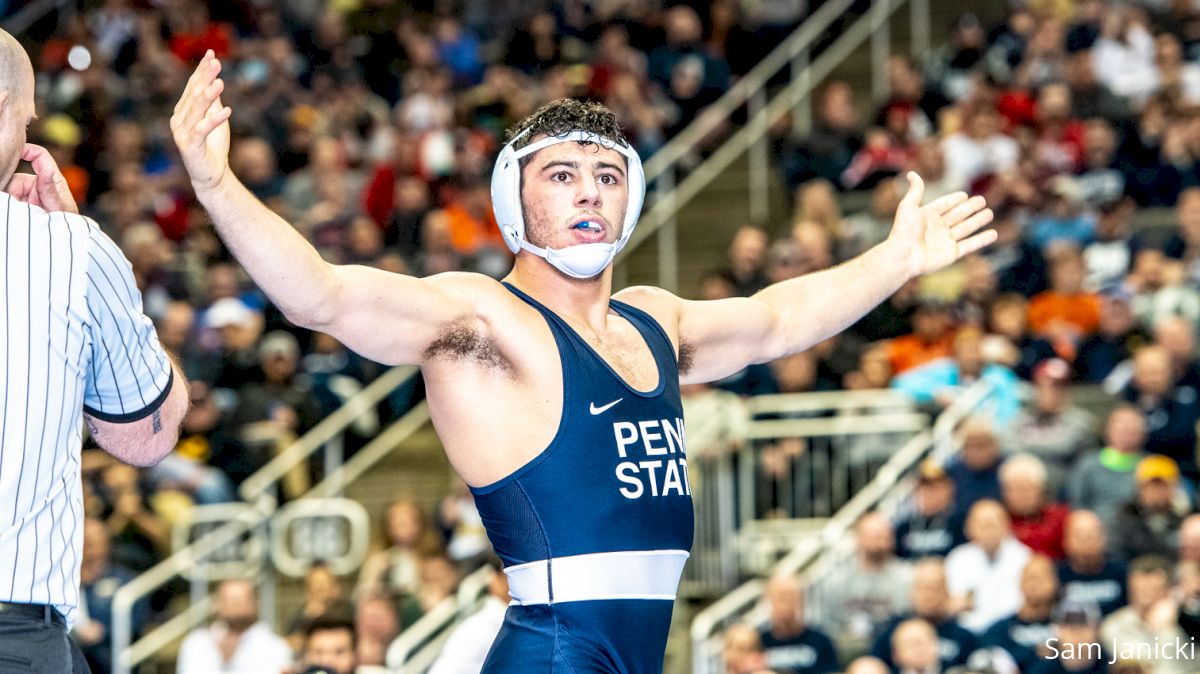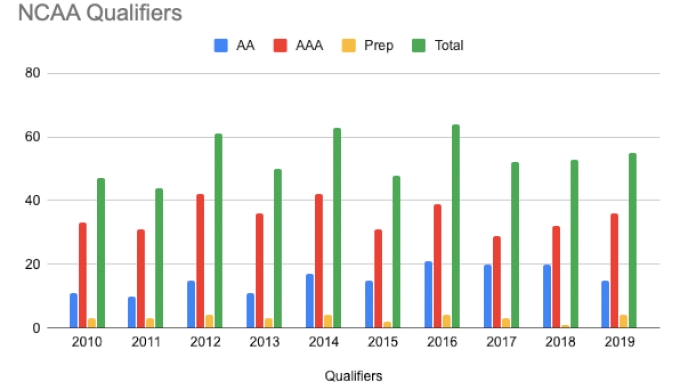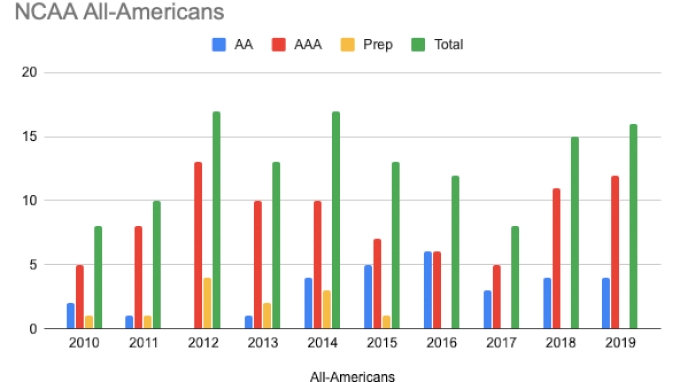PIAA: Does AAA Crush AA At Producing NCAA Talent?
PIAA: Does AAA Crush AA At Producing NCAA Talent?
NCAA championship comparison of the high school talent from the state of Pennsylvania.

Unlock this article, live events, and more with a subscription!
Already a subscriber? Log In
The debate has raged as long as there have been separate classes in Pennsylvania, AA or AAA? The answer is clear that AAA is the superior division, but you need to have perspective about the true differences. The notion that AA is a “JV” division is laughable.
The true difference in the divisions at the very top is very minimal. The finalists in AA stack up to those on the AAA side pretty well. As you get away from the top it becomes pretty lopsided favoring AAA, that point is inarguable. It is also a result of the drawing pool, not talent, development, or any factor that has to do with the actual wrestling.
AAA has a few more schools due to several schools that have a AA qualifying enrollment electing to wrestle in the bigger division. For the current alignment AA has 229 schools with 245 competing in the AAA division. Waynesburg is the current school that is having the most success while electing up, when you consider that Catholic school enrollment creates a unique set of circumstances. Bethlehem Catholic has elected up since 2014-15 season. This is an important note for this study as they have produced many NCAA qualifiers and All-Americans that mostly competed in AA.
The schools are aligned to have equal distribution and the 16 school difference is negligible for our purposes. The important statistic is the pool of eligible athletes that the AAA schools pull from because of their larger enrollment. The model calculates the number of males enrolled from ninth to 11th grade. The cutoff for the largest AA school is 298 male students in those three grades. Schools above the 298 mark wrestle in the AAA division. The total pool of calculated males in AAA schools is 140,017. The AA side only has 43,582. These numbers work out to a ratio of 3.21:1, so I will be using 3:1 to make it easier math. There are so many variables that this is far from a perfect metric to judge the quality per wrestler, but it’s a pretty good metric.
Right after the PIAA Championships, I did a fantasy dual between the AA champs and the AAA champs. Some of the bouts took place during the season or at off-season tournaments. It was still a speculative piece. That isn’t what you're getting here. Here we will be looking at NCAA Qualifiers, All-Americans, and Champions from 2010-2019. The results might surprise you if you’re a AAA elitist.
Starting With Qualifiers
Pennsylvania natives earned 537 bids to the NCAA Championships over the past decade with a high watermark of 64 qualifiers in 2016 and a low mark of 44 qualifiers in 2011. AAA wrestlers earned 351 of these allocations, followed by 155 bids earned by AA wrestlers and 31 qualifying spots were earned by wrestlers from prep schools. This shows the depth of the AAA tournament and proves that it has the most future qualifiers of any state tournament from around the country. Even single class power states of California and New Jersey can match the number of qualifiers.
| Qualifiers | 2010 | 2011 | 2012 | 2013 | 2014 | 2015 | 2016 | 2017 | 2018 | 2019 | |
|---|---|---|---|---|---|---|---|---|---|---|---|
| AA | 11 | 10 | 15 | 11 | 17 | 15 | 21 | 20 | 20 | 15 | 155 |
| AAA | 33 | 31 | 42 | 36 | 42 | 31 | 39 | 29 | 32 | 36 | 351 |
| Prep | 3 | 3 | 4 | 3 | 4 | 2 | 4 | 3 | 1 | 4 | 31 |
| Total | 47 | 44 | 61 | 50 | 63 | 48 | 64 | 52 | 53 | 55 | 537 |
The AA side has far fewer qualifiers. This matches expectations but is not nearly the ratio of 3:1 that would match the advantage AAA has in the number of potential athletes. The AA side had a bit of a surge late in the decade with their highest qualifier totals coming 2016-2018.

Tale Of Two Halves
As I started to collect the data I didn’t know the exact ratio of students by classification. I felt that the qualifier numbers showed AA holding their own. Then the All-American tally started to come in, and I thought that this article was going to change my position that the gap between AA and AAA isn’t as great as some make it out to be. In 2012 there wasn’t a single AA All-American from a AA school. It was looking bleak for the small schools, then the complete data set was filled in.
| All-Americans | 2010 | 2011 | 2012 | 2013 | 2014 | 2015 | 2016 | 2017 | 2018 | 2019 | |
|---|---|---|---|---|---|---|---|---|---|---|---|
| AA | 2 | 1 | 0 | 1 | 4 | 5 | 6 | 3 | 4 | 4 | 30 |
| AAA | 5 | 8 | 13 | 10 | 10 | 7 | 6 | 5 | 11 | 12 | 87 |
| Prep | 1 | 1 | 4 | 2 | 3 | 1 | 0 | 0 | 0 | 0 | 12 |
| Total | 8 | 10 | 17 | 13 | 17 | 13 | 12 | 8 | 15 | 16 | 129 |
AA had an extremely strong second half of the decade where they more than doubled the All-American total from the first five years. In 2016 the AA side matched AAA in the All-American race. The back half of the decade also saw the AA side earn more national championships than AAA. The full range of data shows that the 3:1 ratio of overall students to draw from could be significant as the AAA side has had almost a perfect 3:1 advantage in the All-American tally.

Preps
National Prep schools have not traditionally drawn a lot of the talent away from PIAA member schools. They have shown an ability to identify some top-end talent, even if they aren’t drawing the masses. A third of Pennsylvania natives that attended prep school left the NCAA tournament as an All-American when they qualified. Chris Henrich, Evan Henderson, and Mike McMullen led the way in the first half of the decade. However, the All-Americans weren’t there on the back half of the decade. This will be interesting to watch over the next decade as Wyoming Seminary and Malvern Prep have become major players with a lot of leverage to lure top wrestlers away from the PIAA system.
There are also some asterisks to be placed in the data that heavily sway the prep data. I used the classification that the wrestler competed the majority of their prep career. So Mike Evans and Ed Ruth are classified as AAA wrestlers because they wrestled three years at their AAA high schools. They both finished their careers at Blair Academy. Eight qualifications, seven All-American honors, and Ruth’s three NCAA Championships would be a significant boost to the National Prep data set. There were also several athletes that had a high school career split between the two PIAA divisions. I used the division of the junior and senior seasons if it was a two, two split like Jimmy Gulibon’s career. If the split wasn’t equal I used the majority classification.
Conclusion
For years I have always said, “There isn’t much difference in the top four with a slight edge to AAA. Once you get past the first four the gap widens the further you get away from the high medalists.” I believe this NCAA data reinforces that statement. AA has qualifying level talent. AA has All-American level talent, AA has NCAA Champion level talent. They just don’t have as much of it because of the smaller enrollment.